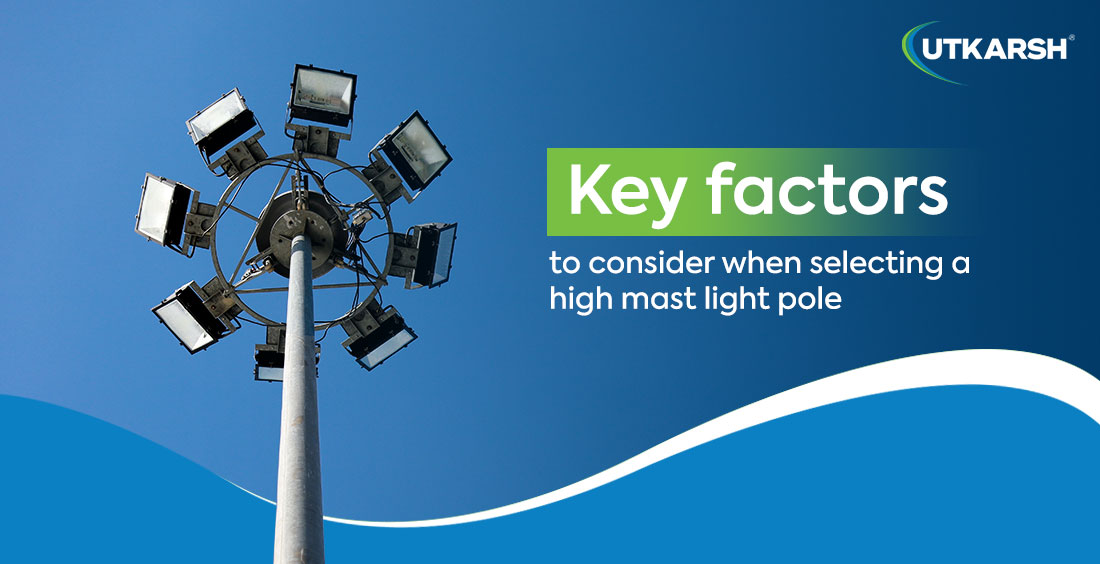Key Factors to Consider When Selecting a High Mast Light Pole

High mast light poles illuminate large outdoor spaces - they are essential for areas where widespread, powerful lighting is necessary. These poles are commonly used in highways, stadiums, industrial zones, ports, airports, and public spaces such as parks or parking lots. Their purpose goes beyond just providing light—they play a crucial role in safety and convenience.
For instance, on highways, high mast poles enhance visibility for drivers, reducing accidents and ensuring smooth traffic flow, especially at night. In stadiums, they create an environment suitable for sporting events, concerts, or other gatherings. Similarly, in industrial zones and ports, these poles ensure work can continue safely and efficiently after dark.
Choosing the right pole is more than just a technical decision—it’s about ensuring the lighting serves its purpose effectively, lasts for years without frequent repairs, and stays cost-efficient. Here, the following useful tips help make the best choice.
1. Height and coverage area
The height of the pole is one of the most important factors. Taller poles cover larger areas, making them perfect for highways and public spaces where wide illumination is needed with fewer shadows. On the other hand, industrial areas might need shorter poles to focus light on specific work zones. It’s also important to consider the type of lights (called luminaires) being used. The pole’s height should match the light’s design to avoid wasting energy or creating uneven lighting.
2. Material and build quality
High mast poles are exposed to tough weather conditions. In summer, they face extreme heat. During the monsoon, they endure heavy rain and humidity. In some regions, strong winds are a concern. To handle these challenges, high mast poles are usually made of steel, which is sturdy and long-lasting. For extra protection against rust and corrosion, especially in coastal or humid areas, the poles are coated with a layer of zinc through a process called hot-dip galvanisation. This coating makes the pole resistant to damage, ensuring it lasts for years with minimal maintenance.
3. Wind load capacity
India experiences diverse weather conditions, including cyclones in coastal regions. Poles must be strong enough to withstand the wind in the area where they are installed. Poles that can’t handle strong winds can bend or fall, causing damage and risking lives. To ensure safety, look for poles that comply with Indian wind load standards, specifically IS 875. These standards provide guidelines for how much wind pressure a pole should be able to handle based on its location.
4. Ease of maintenance
High mast poles are tall, which makes maintenance a challenge. Cleaning the lights or replacing them when they stop working often requires special equipment like cranes or ladders. This can be expensive and time-consuming, especially in remote areas or on busy highways. To make things easier, look for poles with motorised systems that allow the lights to be lowered to the ground for maintenance. This feature saves time, reduces costs, and eliminates the need for heavy machinery.
Looking for a high mast light pole?
Explore our high mast lighting system. Vinaysh is a trustworthy manufacturer of high mast light poles that are designed to light up large outdoor areas such as highways, stadiums, and industrial zones. The high mast poles stand out because of an advanced design process, which uses specialised software and is verified by experts at IIT-Kharagpur to ensure high quality and reliability.
Also Read: Useful insights on Utkarsh High Mast Poles
Flexible installation options are available with both three-point and two-point suspension systems, making the poles suitable for a wide range of uses. All poles are made with rust-resistant materials, including electroplated components such as rope drums and torque limiters. Poles also feature precision-engineered rope drums with grooves that keep cables aligned properly, ensuring smooth and long-lasting operation. The lantern rings, which hold the lights, come in both detachable and fixed options, depending on needs. The durability of these poles is enhanced by a 7-tank galvanising process that ensures a strong, even coating that prevents rust. HDPE buffers provide added protection of the lantern rings. Safety is a top priority. Trailing cables meet strict Indian safety standards (IS 9968), and additional protection features such as anti-theft nuts for the foundation bolts are offered. Motors have dual safety systems—both mechanical and electrical—to prevent accidents.
Each component is tested rigorously. Facilities include advanced tools, including spectrometers, for checking the chemical quality of materials. Wind tunnel tests at IIT-Kanpur verify that poles can withstand tough conditions, including strong winds.
Conclusion
Choosing the right high mast light pole is crucial for ensuring long-lasting performance, safety, and efficient illumination across large outdoor areas. From selecting the ideal height and material to ensuring compliance with wind load standards and prioritising ease of maintenance, every factor plays an important role. With a dependable manufacturer that focuses on quality engineering, rigorous testing, and safety-driven design, confidence in lighting infrastructure delivering reliable results for years is well placed. Investing in a well-designed high mast lighting system not only enhances visibility but also contributes to safer and more productive environments across highways, stadiums, industrial zones, and public spaces.